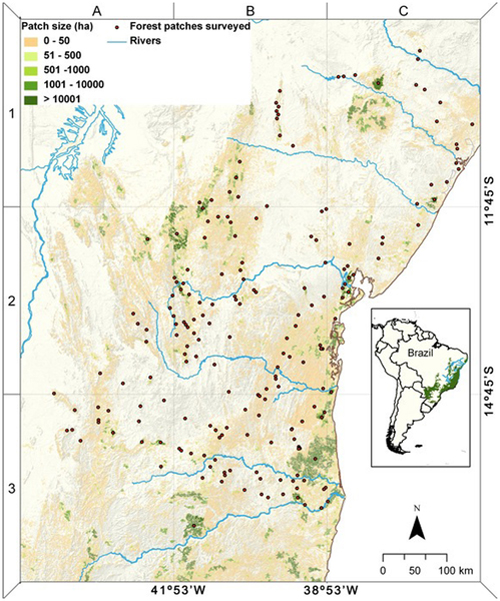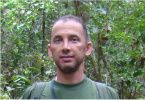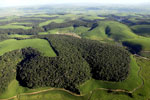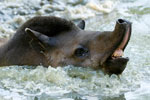
New research shows that the lowland tapir is nearly extinct in the Atlantic Forest. Photo by: Jeremy Hance.
When the Portuguese first arrived on the shores of what is now Brazil, a massive forest waited for them. Not the Amazon, but the Atlantic Forest, stretching for over 1.2 million kilometers. Here jaguars, the continent’s apex predator, stalked peccaries, while tapirs waded in rivers and giant anteaters unearthed termites mounds. Here, also, the Tupi people numbered around a million people. Now, almost all of this gone: 93 percent of the Atlantic Forest has been converted to agriculture, pasture, and cities, the bulk of it lost since the 1940s. The Tupi people are largely vanished due to slavery and disease, and, according to a new study in the open access journal PLoS ONE, so are many of the forest’s megafauna, from jaguars to giant anteaters.
“We uncovered a staggering process of local extinctions of mid-sized and large mammals,” said co-author Gustavo Canale of the State University of Mato Grosso (UNEMAT) in a press release.
The study found that forest fragments, such as those that make-up the Atlantic Forest today, are not enough to save many mammals from local extinction, raising concern for tropical forests around the world as many are being cleared into fragments in much the same way the Atlantic Forest over the past few centuries.
Examining 18 mammal species across 196 forest fragments in the Atlantic Forest, the researchers found “unprecedented rates of local extinctions,” despite the fact that they purposefully visited the “most intact and best preserved” sites in the region. On average only about 4 target mammals were found out of 18 (around 22 percent) in each forest patch, with some fragments, not surprisingly, performing better than others. None of the nearly two hundred sites contained all 18 mammals. The findings undercut assumptions made by the widely used theory of species-area relationships, which predicted that around 45-80 percent of the mammals would have remained.
 Map of Atlantic Forest biome. Click to enlarge. |
Worryingly even some large forest patches with intact canopies had been depleted of the target mammals. Even the biggest fragments contained on average less than eight of the target species.
“You might expect forest fragments with a relatively intact canopy structure to still support high levels of biodiversity,” explains lead author Carlos Peres, of UEA’s School of Environmental Sciences. “Our study demonstrates that this is rarely the case, unless these fragments are strictly protected from hunting pressure.”
Hunting and poaching had decimated many of the mammal species even in habitats where they would thought to be present. In addition, forest fragments suffered from edge effects, such as drying out and wind vulnerability, and an increased likelihood of fires, a rarity in tropical rainforests.
Some mammals are nearly, or entirely, gone for good. The study found no evidence that white-lipped peccaries survived anywhere in the Atlantic Forest, while lowland tapirs, woolly spider monkeys, jaguars, and giant anteaters were each only found in 0.5 to 3 percent of the surveyed forests. Most of the surviving targeted mammals were small, including marmosets, titi monkeys, and nine-banded armadillos.
Many of the once-common species were even absent from human memory, a phenomenon that has become known to scientists as shifting baselines, i.e. where humans rapidly forget what an ecosystem once was.
“Interviews clearly indicated that there was no record in recent memory of these otherwise widespread species in all but a few forest fragments
surveyed,” the researchers write, adding that, “the largest five species were reported by 98 percent of all interviewees to have disappeared from local folklore, and were no longer pursued by subsistence hunters.”
The study did point to a remedy: protected areas. The key to mammal survival in the Atlantic Forest was more related to legal protection than even the size of the fragments with protected areas containing three times as many target species as non-protected areas.
“We therefore recommend the implementation of new strictly protected areas, such as National Parks and Biological Reserves, including forest fragments containing populations of endangered, rare and endemic species, particularly those facing imminent extinctions,” says Canale. Today, less than 2 percent of the Atlantic Forest is under strict protection.
Despite this, the trend in the Atlantic Forest is going in the opposite direction of greater protection and conservation.
“A growing number of reserves are being degraded, downsized, if not entirely degazetted, so holding on to the last remaining large tracts of primary forests will be a crucial part of the conservation mission this century,” explains Peres.
Many of the world’s once great rainforests—from Sumatra to Madagascar and Uganda to Papua New Guinea—are being whittled away in much the same manner as the Atlantic Forest was 50 years ago, when only 3 billion people occupied the planet. And their mammals, from tigers to lemurs, are facing the same onslaughts as the largely vanished jaguars and giant anteaters of the Atlantic Forest.
“Human populations are exploding and very few areas remain untouched by the expanding cornucopia of human impacts,” says Peres. “It is therefore essential to enforce protection in areas that are nominally protected ‘on paper’. The future of tropical forest wildlife depends on it.”

Dots show surveyed patches of forest across the Atlantic Forest. Map courtesy of paper.
CITATION: Canale GR, Peres CA, Guidorizzi CE, Gatto CAF, Kierulff MCM (2012) Pervasive Defaunation of Forest Remnants in a Tropical Biodiversity Hotspot. PLoS ONE 7(8): e41671. doi:10.1371/journal.pone.0041671.
Related articles

(09/23/2009) The Atlantic Forest may very well be the most imperiled tropical ecosystem in the world: it is estimated that seven percent (or less) of the original forest remains. Lining the coast of Brazil, what is left of the forest is largely patches and fragments that are hemmed in by metropolises and monocultures. Yet, some areas are worse than others, such as the Pernambuco Endemism Centre, a region in the northeast that has largely been ignored by scientists and conservation efforts. Here, 98 percent of the forest is gone, and 70 percent of what remains are patches measuring less than 10 hectares. Due to this fragmentation all large mammals have gone regionally extinct and the small mammals are described by Antonio Rossano Mendes Pontes, a professor and researcher at the Federal University of Pernambuco, as the ‘living dead’.
Deforestation in Brazil’s Mata Atlantica drops
(06/06/2012) Deforestation of Brazil’s Mata Atlântica — a forest ecosystem more threatened than the Amazon rainforest — fell to 133 square kilometers between 2010 and 2011, down about 14.7 percent from the annual average between 2008 and 2010, reports Brazil’s National Institute for Space Research (INPE) and Fundação SOS Mata Atlântica.
Tribe partners to protect Argentina’s most endangered forest

(05/17/2012) Last month, three Guarani communities, the local Argentine government of Misiones, and the UK-based NGO World Land Trust forged an agreement to create a nature reserve connecting three protected areas in the fractured, and almost extinct, Atlantic Forest. Dubbed the Emerald Green Corridor, the reserve protects 3,764 hectares (9,301 acres) in Argentina; although relatively small, the land connects three protected other protected areas creating a combined conservation area (41,000 hectares) around the size of Barbados in the greater Yaboti Biosphere Reserve. In Argentina only 1 percent of the historical Atlantic Forest survives.
Invasive primates threaten Atlantic Forest natives
(03/19/2012) Scientists have called for the removal of eight invasive primates from Brazil’s imperiled Atlantic Forest in a new study published in mongabay.com’s open access journal Tropical Conservation Society. The researchers fear that the eight alien monkeys could hurt other species due to increased competition, predation, and possible disease.
Expanding ethanol threatens last remnants of Atlantic Forest

(09/26/2011) Aggressively expanding sugarcane ethanol is putting Brazil’s nearly-vanished Atlantic Forest at risk, according to an opinion piece in mongabay.com’s open-access journal Tropical Conservation Science. Already down to less than 12 percent of its original extent, the Atlantic Forest—home to over 7,000 species that survive no-where else—is facing a new peril from ethanol, used as an alternative to gasoline and often touted as ‘green’ or ‘environmentally-sustainable’.
Atlantic Forest stores less carbon due to drastic fragmentation
(09/26/2011) The Atlantic Forest in Brazil is one of the most fragmented and damaged forests in the world. Currently around 12 percent of the forest survives, with much of it in small fragments, many less than 100 hectares. A new study in mongabay.com’s open-access journal Tropical Conservation Science finds that the bloodied nature of the Atlantic Forest impacts its capacity to sequester carbon. The study found that 92 percent of the forest stored only half its potential carbon due to fragmentation and edge-effects, which includes damage due to winds and exposure to drought.
Loving the tapir: pioneering conservation for South America’s biggest animal

(09/11/2011) Compared to some of South America’s megafauna stand-out species—the jaguar, the anaconda, and the harpy eagle come to mind—the tapir doesn’t get a lot of love. This is a shame. For one thing, they’re the largest terrestrial animal on the South American continent: pound-for-pound they beat both the jaguar and the llama. For another they play a very significant role in their ecosystem: they disperse seeds, modify habitats, and are periodic prey to big predators. For another, modern tapirs are some of the last survivors of a megafauna family that roamed much of the northern hemisphere, including North America, and only declined during the Pleistocene extinction. Finally, for anyone fortunate enough to have witnessed the often-shy tapir in the wild, one knows there is something mystical and ancient about these admittedly strange-looking beasts.
Destruction of Brazil’s most endangered forest, the Mata Atlantica, slows

(05/27/2011) Deforestation of Brazil’s most threatened forest ecosystem dropped substantially during the 2008-2010 period according to new data released by Brazil’s National Institute for Space Research (INPE) and Fundação SOS Mata Atlântica. Analysis of satellite images across 16 of the 17 states the Atlantic Forest spans found that 312 square kilometers of forest was cleared between 2008 and 2010, down from 1,029 square kilometers between 2005 and 2008. Deforestation was concentrated in the states of Minas Gerais, Bahia, Santa Catarina and Parana.
2,700 sq km of Brazil’s most endangered rainforest destroyed in 8 years
(12/03/2010) 270,000 hectares of the Mata Atlântica, Brazil’s most threatened ecosystem, was cleared between 2002 and 2008, reports a new assessment by the Brazilian Institute of Environment and Natural Resources (IBAMA). Less than 8 percent of the Atlantic forest—famed for its biodiversity—remains.
New protected areas established in Brazil’s fragmented Atlantic Forest
(06/17/2010) Brazil has designated an additional 65,070 hectare (161,000 acres) of land to be protected in the Mata Atlantica, or Atlantic Forest. The land is split between four new protected areas and an expansion of a national park.